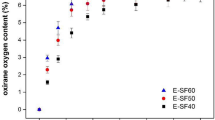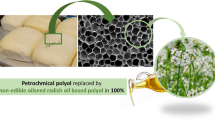Abstract
The use of petroleum-derived products should be avoided regarding the principles of green and sustainable chemistry. The work reported herein, is aimed at the liquefaction of pine shavings for the production of an environmentally-friendly polyol suitable to be used in the formulations of sprayable polyurethane foams. The biopolyols were obtained in high yield and were used to replace those derived from fossil sources, to produce more “greener” polyurethane foams and therefore, less dependent on petroleum sources, since the polyol component was substituted by products resulting from biomass liquefaction. The partial and fully exchange of the polyols was accomplished, and the results compared with a reference foam. The foams were afterward, chemical, physical, morphological, and mechanically characterized. The complete replacement of polyether polyol and polyol polyester has presented some similar characteristics as that used as a reference, validating that the path chosen for the development of more sustainable materials is on the right track for the contribution to a cleaner world.








Similar content being viewed by others
References
King D (2010) The Future of industrial biorefineries. World Economic Forum White Paper, Cologny/Geneva
Karger-Kocsis J (2011) Liquefaction of plant biomass for use in polymers—is it the right strategy? Express Polym Lett 5:92–92. doi:10.3144/expresspolymlett.2011.10
Ma L, Wang T, Liu Q et al (2012) A review of thermal–chemical conversion of lignocellulosic biomass in China. Biotechnol Adv 30:859–873. doi:10.1016/j.biotechadv.2012.01.016
Gama NV, Soares B, Freire CSR, et al (2015) Bio-based polyurethane foams toward applications beyond thermal insulation. Mater Des 76:77–85. doi:10.1016/j.matdes.2015.03.032
Soares B, Gama N, Freire C et al (2014) Ecopolyol production from industrial cork powder via acid liquefaction using polyhydric alcohols. ACS Sustain. Chem Eng 2:846–854. doi:10.1021/sc400488c
Bordado JC, Silva E, dos Santos RG, et al (2015) WO2015034383—Two-component natural polymeric water-based glues, obtained from derivatives of cork.
Pan H (2011) Synthesis of polymers from organic solvent liquefied biomass: a review. Renew Sustain Energy Rev 15:3454–3463. doi:10.1016/j.rser.2011.05.002
Jasiukaityte E, Kunaver M, Strlic M (2009) Cellulose liquefaction in acidified ethylene glycol. Cellulose 16:393–405. doi:10.1007/s10570-009-9288-y
Mateus MM, Carvalho R, Bordado JC, dos Santos RG (2015) Biomass acid-catalyzed liquefaction—Catalysts performance and polyhydric alcohol influence. Data Br 5:736–738. doi:10.1016/j.dib.2015.10.037
Hassan EM, Shukry N (2008) Polyhydric alcohol liquefaction of some lignocellulosic agricultural residues. Ind Crops Prod 27:33–38. doi:10.1016/j.indcrop.2007.07.004
Krzan A, Kunaver M (2006) Microwave heating in wood liquefaction. J Appl Polym Sci 101:1051–1056. doi:10.1002/app.23488
dos Santos RG, Bordado JC, Mateus MM (2015) Microwave-assisted liquefaction of cork—from an industrial waste to sustainable chemicals. Ind Eng Manag 4:173–177. doi:10.4172/2169-0316.1000173
Mateus MM, Acero NF, Bordado JC, dos Santos RG (2015) Sonication as a foremost tool to improve cork liquefaction. Ind Crop Prod 74:9–13. doi:10.1016/j.indcrop.2015.04.063
García A, Alriols MG, Llano-Ponte R, Labidi J (2011) Ultrasound-assisted fractionation of the lignocellulosic material. Bioresour Technol 102:6326–6330. doi:10.1016/j.biortech.2011.02.045
Kunaver M, Jasiukaitytė E, Čuk N (2012) Ultrasonically assisted liquefaction of lignocellulosic materials. Bioresour Technol 103:360–366. doi:10.1016/j.biortech.2011.09.051
Roslan R, Zakaria S, Chia CH et al (2014) Physico-mechanical properties of resol phenolic adhesives derived from liquefaction of oil palm empty fruit bunch fibres. Ind Crops Prod 62:119–124. doi:10.1016/j.indcrop.2014.08.024
dos Santos RG, Carvalho R, Silva ER et al (2016) Natural polymeric water-based adhesive from cork liquefaction. Ind Crops Prod 84:314–319. doi:10.1016/j.indcrop.2016.02.020
Gama NV, Soares B, Freire CSR et al (2015) Rigid polyurethane foams derived from cork liquefied at atmospheric pressure. Polym Int 64:250–257. doi:10.1002/pi.4783
Hu S, Luo X, Li Y (2014) Polyols and polyurethanes from the liquefaction of lignocellulosic biomass. ChemSusChem 7:66–72. doi:10.1002/cssc.201300760
Seljak T, Oprešnik SR, Kunaver M, Katrašnik T (2012) Wood, liquefied in polyhydroxy alcohols as a fuel for gas turbines. Appl Energy 99:40–49. doi:10.1016/j.apenergy.2012.04.043
Briones R, Serrano L, Llano-Ponte R, Labidi J (2011) Polyols obtained from solvolysis liquefaction of biodiesel production solid residues. Chem Eng J 175:169–175. doi:10.1016/j.cej.2011.09.090
dos Santos RG, Bordado JC, Mateus MM (2016) Thermochemical liquefaction of swine manure as feedstock for the production of a potential biofuel. Innov. Energy Res.
Mateus MM, Bordado JC, dos Santos RG (2016) Potential biofuel from liquefied cork—higher heating value comparison. Fuel 174:114–117. doi:10.1016/j.fuel.2016.01.081
Briones R, Serrano L, Labidi J (2012) Valorization of some lignocellulosic agro-industrial residues to obtain biopolyols. J Chem Technol Biotechnol 87:244–249. doi:10.1002/jctb.2706
Yona AMC, Budija F, Kričej B et al (2014) Production of biomaterials from cork: liquefaction in polyhydric alcohols at moderate temperatures. Ind Crops Prod 54:296–301. doi:10.1016/j.indcrop.2014.01.027
Wang H, Chen H-Z (2007) A novel method of utilizing the biomass resource: rapid liquefaction of wheat straw and preparation of biodegradable polyurethane foam (PUF). J Chinese Inst. Chem Eng 38:95–102. doi:10.1016/j.jcice.2006.10.004
Hu S, Li Y (2014) Polyols and polyurethane foams from base-catalyzed liquefaction of lignocellulosic biomass by crude glycerol: effects of crude glycerol impurities. Ind Crops Prod 57:188–194. doi:10.1016/j.indcrop.2014.03.032
Cheumani-Yona AM, Budija F, Hrastnik D et al (2015) Preparation of Two-Component Polyurethane Coatings from Bleached Liquefied Wood. BioResources 10(2):3347–3363
De Schrijver A (2012) The foam manual: polyurethane foam systems for professionals and DIY, 2nd edn.
Marques AC, Dias H, Matos S et al (2016) Polyurethane one-component foam formulation optimization for low free isocianate monomer content. J Cell Plast. doi:10.1177/0021955X16639230
Galhano dos Santos R, Bordado JC, Mateus MM (2016) Potential biofuels from liquefied industrial wastes—preliminary evaluation of heats of combustion and van Krevelen correlations. J Clean Prod. doi:10.1016/j.jclepro.2016.07.082
Lee S-H, Teramoto Y, Shiraishi N (2002) Biodegradable polyurethane foam from liquefied waste paper and its thermal stability, biodegradability, and genotoxicity. J Appl Polym Sci 83:1482–1489. doi:10.1002/app.10039
Xie J, Zhai X, Hse C et al (2015) Polyols from microwave liquefied bagasse and its application to rigid polyurethane foam. Materials (Basel) 8:5472
Grilc M, Veryasov G, Likozar B et al (2015) Hydrodeoxygenation of solvolysed lignocellulosic biomass by unsupported MoS2, MoO2, Mo2C and WS2 catalysts. Appl Catal B Environ 163:467–477. doi:10.1016/j.apcatb.2014.08.032
Grilc M, Likozar B, Levec J (2014) Hydrotreatment of solvolytically liquefied lignocellulosic biomass over NiMo/Al2O3 catalyst: reaction mechanism, hydrodeoxygenation kinetics and mass transfer model based on FTIR. Biomass Bioenergy 63:300–312. doi:10.1016/j.biombioe.2014.02.014
Xiao B, Sun XF, Sun R (2001) Chemical, structural, and thermal characterizations of alkali-soluble lignins and hemicelluloses, and cellulose from maize stems, rye straw, and rice straw. Polym Degrad Stab 74:307–319. doi:10.1016/S0141-3910(01)00163-X
Cengiz M, Dincturk OD, Sahin HT (2010) Fractional extraction and structural characterization of opium poppy and cotton stalks hemicelluloses. Pharmacogn Mag 6:315–319. doi:10.4103/0973-1296.71798
Sun JX, Mao FC, Sun XF, Sun R (2005) Comparative study of hemicelluloses isolated with alkaline peroxide from lignocellulosic materials. J Wood Chem Technol 24:239–262. doi:10.1081/WCT-200038170
van Putten R-J, van der Waal JC, de Jong E et al (2013) Hydroxymethylfurfural, a versatile platform chemical made from renewable resources. Chem Rev 113:1499–1597. doi:10.1021/cr300182k
Tay GS, Ong LN, Rozman HD (2012) Mechanical properties and fire retardant behavior of polyurethane foam reinforced with oil palm empty fruit bunch. J Appl Polym Sci 125:158–164. doi:10.1002/app.35568
Acknowledgements
R. Galhano dos Santos and A. C. Marques would like to acknowledge FCT—Fundação para a Ciência e Tecnologia for the Postdoctoral Grants SFRH/BPD/105662/2015 and SFRH/BPD/96697/2013, respectively. We are grateful to Prof. Fátima Vaz for performing the mechanical tests.
Author information
Authors and Affiliations
Corresponding author
Rights and permissions
About this article
Cite this article
Galhano dos Santos, R., Acero, N.F., Matos, S. et al. One-Component Spray Polyurethane Foam from Liquefied Pinewood Polyols: Pursuing Eco-Friendly Materials. J Polym Environ 26, 91–100 (2018). https://doi.org/10.1007/s10924-016-0931-z
Published:
Issue Date:
DOI: https://doi.org/10.1007/s10924-016-0931-z




